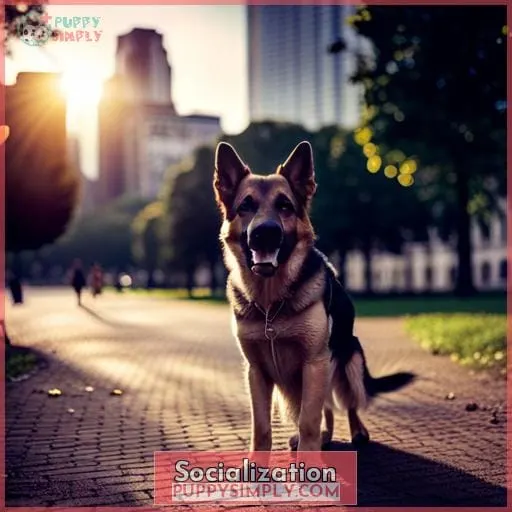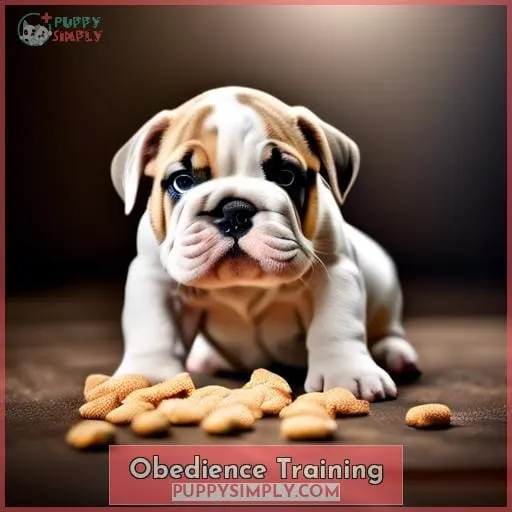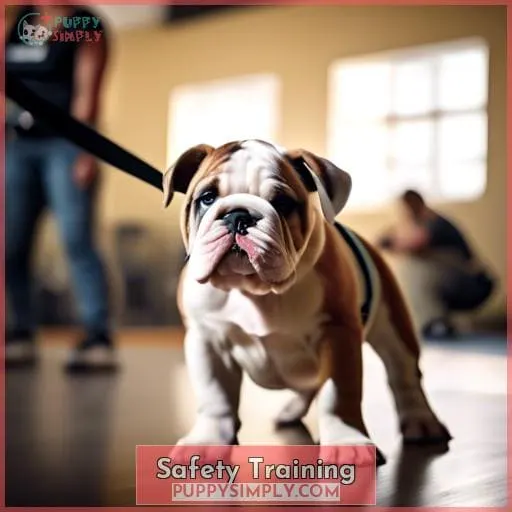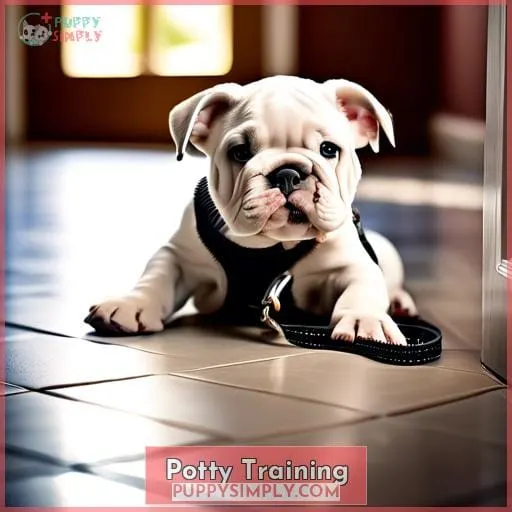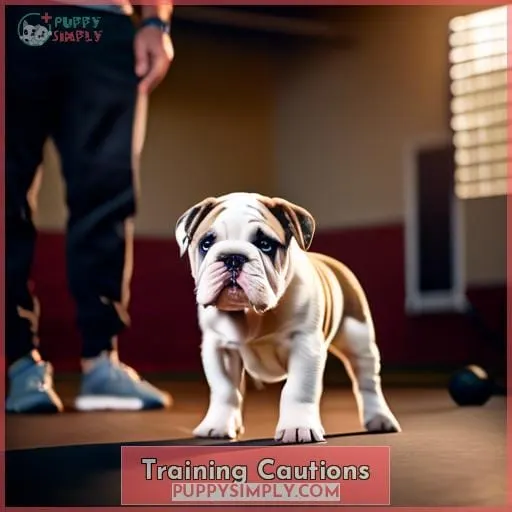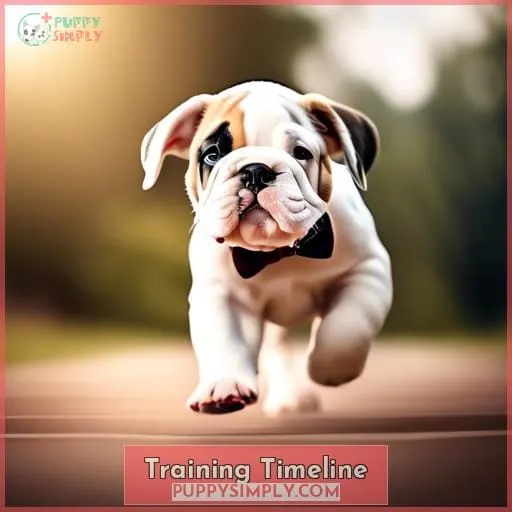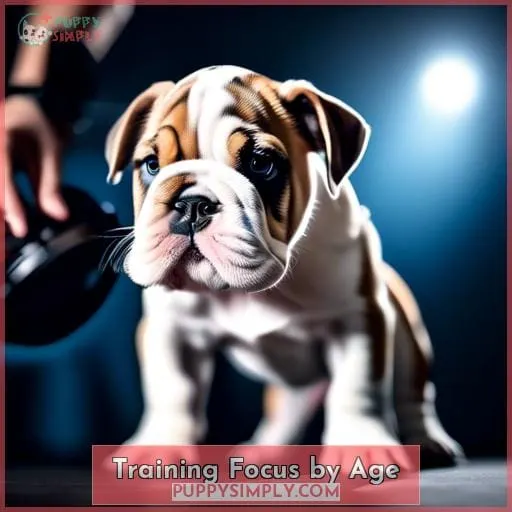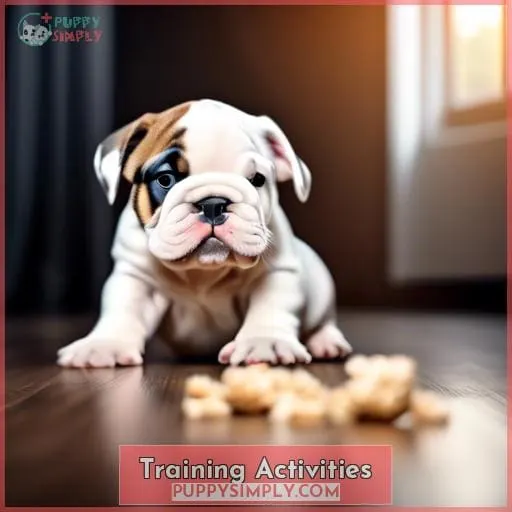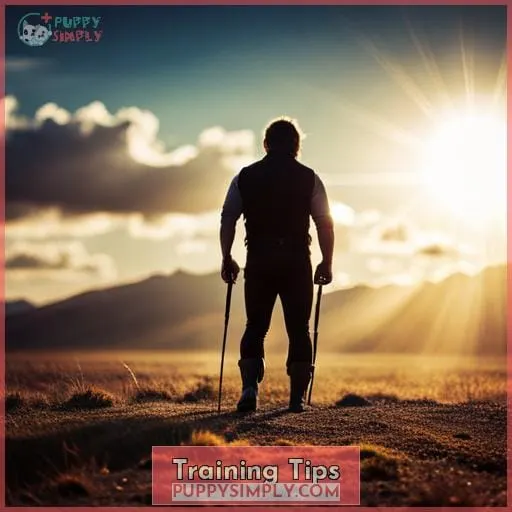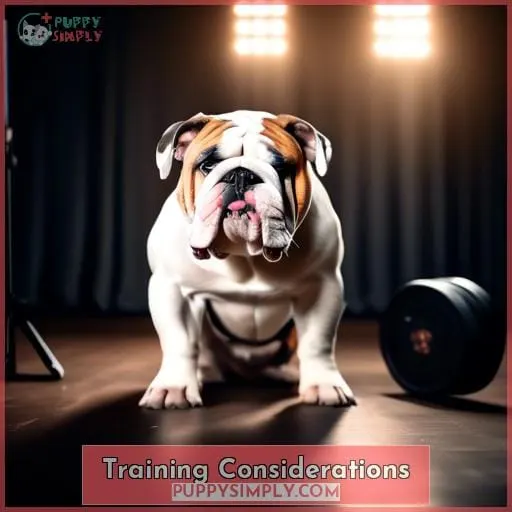This site is supported by our readers. We may earn a commission, at no cost to you, if you purchase through links.
 Training Guide for Stubbornly Adorable Canines:
Training Guide for Stubbornly Adorable Canines:
You’ve fallen for their charms, but now you’re wondering: are English Bulldogs easy to train?
The answer’s not as straightforward as you’d like.
While they can be stubborn, these loyal companions also crave your approval.
With patience, consistency, and the right approach, you can train your Bulldog.
This guide will show you how.
Table Of Contents
- Key Takeaways
- Socialization
- Obedience Training
- Safety Training
- Potty Training
- Training Cautions
- Training Timeline
- Training Focus by Age
- Training Activities
- Training Tips
- Training Considerations
- Frequently Asked Questions (FAQs)
- How can I encourage my English Bulldog to play with toys?
- What strategies can I employ to prevent my English Bulldog from chewing on furniture?
- How can I teach my English Bulldog to walk on a leash without pulling?
- What methods can I use to train my English Bulldog to come when called?
- How can I help my English Bulldog overcome separation anxiety?
- Conclusion
Key Takeaways
- English Bulldogs require early and consistent socialization to ensure comfort around people and animals.
- Positive reinforcement with treats and praise is essential for successful obedience training.
- Safety training includes leash training, teaching Drop It and Leave It commands, and socializing with humans and animals to prevent aggression.
- Potty training involves establishing a designated elimination spot, sticking to a schedule, using a consistent verbal command, and rewarding successful elimination.
Socialization
You can socialize your English Bulldog from an early age to ensure they’re comfortable with people and other animals.
Start by introducing your puppy to new people and animals in a controlled environment. Keep the interactions positive and rewarding, using treats and praise to reinforce good behavior.
Gradually expose your puppy to different situations, such as busy streets, parks, and pet stores. The more socialization your puppy experiences, the more confident and adaptable they’ll become.
Socializing your English Bulldog puppy is crucial for their overall development and well-being. It helps them learn how to interact appropriately with people and other animals, reducing the risk of fear-based aggression or anxiety.
A well-socialized English Bulldog is a joy to be around, bringing happiness and companionship to your family and friends.
Obedience Training
Now that your furry pal has been properly socialized, it’s time to embark on the journey of obedience training.
Bulldogs are known for their stubbornness, but don’t let that discourage you. With patience, consistency, and the right techniques, you can transform your English Bulldog into a well-behaved companion.
Start with the basics: sit, stay, come, and heel. Use positive reinforcement methods, like treats, praise, and petting, to reward your dog for following your commands. Keep training sessions short and sweet, no more than 5-10 minutes at a time, to maintain your dog’s focus.
Repetition is key, as Bulldogs have short-term memory, so be prepared to repeat commands often.
Introduce leash training early on to ensure your dog behaves well on walks. Start by letting your dog wear the leash inside the house, then gradually transition to walks outside.
Crate training and potty training go hand in hand with obedience training. Create a positive association with the crate by making it a cozy and comfortable space. Feed your dog meals and treats inside the crate, and gradually increase the time spent inside.
For potty training, take your dog outside frequently, especially after meals, naps, and playtime. Choose a designated spot, use a consistent command, and reward your dog immediately for eliminating in the right place.
Safety Training
While teaching your English Bulldog basic commands, you can also incorporate safety training to prevent aggression and ensure their well-being.
Follow these four steps to instill safe behaviors in your furry friend:
-
Teach Them to Drop It and Leave It:
- These commands are crucial for preventing aggression and ensuring your Bulldog doesn’t pick up potentially dangerous objects.
- Use treats and praise to reward your Bulldog when they drop or leave an object upon command.
- Leash training is essential for controlling your Bulldog in public and preventing them from running off.
- Start leash training early, using a harness instead of a choke collar to avoid potential health issues.
- If your Bulldog displays food aggression, approach mealtime cautiously.
- Avoid touching their food or bowl while they’re eating, and train them to sit and stay before you place the bowl down.
- Early socialization helps prevent aggression towards other people and animals.
- Take your Bulldog to puppy socialization classes and introduce them to various people and animals in a controlled environment.
Potty Training
Potty training your English Bulldog puppy involves establishing a consistent routine that sets the foundation for a well-behaved companion.
Begin by selecting a designated elimination spot outdoors, preferably a grassy area away from high-traffic zones.
Stick to a potty training schedule, taking your puppy out first thing in the morning, after meals, naps, and playtime, and before bedtime.
Consistency is key—choose a specific verbal command, like Go potty, and use it every time you take your puppy out.
Upon successful elimination in the designated spot, shower your puppy with verbal praise and an occasional treat to reinforce the desired behavior.
Accidents may happen during the training process; when they do, avoid punishment, as it can instill fear and hinder progress.
Instead, clean up the mess with enzymatic cleaners that eliminate odors and discourage your puppy from repeating the mistake in the same spot.
Patience and positive reinforcement are essential; remember, potty training takes time and dedication.
Celebrate each successful outdoor elimination as a milestone in your puppy’s development, and gradually increase the time between potty breaks as your puppy gains control.
With consistency, patience, and positive reinforcement, your English Bulldog will soon learn the proper potty etiquette, solidifying their role as a cherished member of your family.
Training Cautions
To ensure a safe and effective training experience, you must be aware of certain precautions specific to English Bulldogs.
Their temperament and stubbornness demand patience, consistency, and positive reinforcement methods.
Bulldogs have limitations due to their health and care needs. Avoid strenuous activities and agility training, as these can exacerbate potential orthopedic problems. Their shortened faces cause breathing difficulties, so training indoors in a climate-controlled environment is crucial.
Overheating can be fatal, so provide plenty of fresh water during training to prevent phlegm buildup.
Never use a choke collar on an English Bulldog; it can cause severe respiratory distress. Instead, opt for a harness that won’t restrict their breathing. Be mindful of their chewing habits, as their strong jaws can easily damage furniture and personal belongings.
Training an English Bulldog requires dedication and understanding of their unique needs. With patience, consistency, and the right approach, you can help your Bulldog thrive and become a well-behaved companion.
Training Timeline
- Let’s explore the appropriate training timeline for your English bulldog, starting with early socialization and command training as a puppy:
- Begin socializing your bulldog puppy between 8 and 16 weeks old.
- Introduce them to various people, animals, and environments to build confidence and prevent future anxieties.
- Start basic command training during this period, focusing on commands like sit, stay, and come.
- Keep training sessions short, around 5-10 minutes, to maintain their attention.
As your bulldog matures, continue obedience training:
- Enroll them in puppy classes or work with a professional trainer to refine their commands and introduce more advanced ones.
- Simultaneously, focus on potty training by designating a specific elimination spot outdoors and consistently taking them there after meals and naps.
- Accidents happen, so clean them up with an enzymatic cleaner and avoid punishment.
Around 6 months, your bulldog should grasp basic obedience and be comfortable with daily routines:
- Continue reinforcing these skills while introducing enriching activities like puzzle feeders and interactive toys to stimulate their minds.
- Supervise playtime to prevent roughhousing, which can lead to injuries due to their stocky build.
Training Focus by Age
How should you tailor training to your English Bulldog’s age and developmental stage?
The breed’s unique characteristics and common training challenges demand specific techniques at different stages of their life.
From 8 to 16 weeks:
- Focus on socialization, basic commands, and potty training.
- Introduce them to various people, animals, and environments to build confidence.
- Start with simple commands like sit and stay, using positive reinforcement and short, frequent sessions.
- Begin potty training by taking your puppy out regularly and praising them for using the designated spot.
At 6 months:
- Continue obedience training, emphasizing consistency in approach.
- Bulldogs can be stubborn, so patience and positive reinforcement are key.
- Introduce activities like tracking and agility, keeping sessions short and engaging.
- Ensure they get plenty of exercise, but avoid strenuous activities that could harm their joints.
By 1 year:
- Your Bulldog should know basic obedience commands and have a daily routine.
- Continue training with advanced commands and incorporate training classes into their exercise routine.
- Bulldogs thrive on mental stimulation, so keep training sessions varied and interesting.
Training Activities
Now that we’ve covered the basics of training your English Bulldog, let’s delve into some specific activities that can help reinforce their learning and make training more enjoyable for both of you.
Start with obedience classes. These classes provide a structured environment where your bulldog can learn basic commands, socialize with other dogs, and get used to being around new people. Plus, you’ll receive expert guidance from a qualified trainer, ensuring you’re using the most effective training methods.
Incorporating tracking and agility exercises into your bulldog’s routine is a great way to keep them active and engaged. Tracking exercises stimulate their natural hunting instincts, while agility exercises challenge their physical and mental abilities.
These activities not only provide a fun outlet for their energy but also strengthen your bond with them.
Don’t forget about leash training. This is crucial for ensuring your bulldog’s safety during walks and outings. Start by introducing them to the leash indoors, then gradually transition to outdoor walks.
Use a waterproof harness instead of a collar to prevent trachea damage, a common issue in bulldogs.
Finally, establish house rules and boundaries. Make sure your bulldog knows where they’re allowed to go and what behaviors are acceptable.
Training Tips
Employ various training techniques to keep your English bulldog engaged and focused during training sessions. Utilize treats and praise to reward desired behaviors promptly, creating a positive association between training and enjoyment.
Introduce crate training early, transforming the crate into a cozy and comfortable space. This safe haven will provide your bulldog with a sense of security and familiarity, making training sessions more productive.
Keep training sessions short and sweet, around 5-10 minutes each. Bulldogs have short attention spans, so maintaining their focus requires concise and engaging sessions. Vary the training location and activities to prevent boredom and maintain their enthusiasm.
Discipline your bulldog with patience and consistency. Never resort to physical punishment or harsh words, as these methods will only instill fear and resentment. Instead, employ positive reinforcement techniques, such as treats, praise, and play, to shape desired behaviors.
Training Considerations
As you begin training your Bulldog, remember that positive reinforcement is key.
Keep your training sessions short and sweet, as Bulldogs have short attention spans.
Patience and consistency are also essential, as Bulldogs can be stubborn and may not learn as quickly as other breeds.
Positive Reinforcement Methods
By utilizing positive reinforcement methods during training, you can leverage Bulldogs’ food-motivated nature to achieve desired behaviors.
Employ treats and praise to reward desired behaviors, creating a positive association with training.
Conduct short daily sessions, maintaining consistency and patience.
Positive reinforcement fosters a strong bond between you and your Bulldog, making training an enjoyable and rewarding experience for both of you.
Short Training Sessions
With their short attention spans, keep training sessions to 5-10 minutes. Short bursts of training help English bulldogs focus and retain information better.
-
Positive Reinforcement:
- Use treats, praise, and petting to reward desired behaviors.
-
Consistency in Training:
- Stick to a regular training schedule and use the same commands each time.
-
Leash Training:
- Start leash training early to prevent pulling and lunging.
Patience and Consistency
Patience and consistency will often help you achieve training success with your English Bulldog.
Consistent techniques and persistent training will help your dog learn and retain commands.
You must have the endurance to provide steady guidance and continuous reinforcement, even when your dog tests your limits.
This may be challenging, but with patience and consistency, you’ll build a strong bond with your English Bulldog and enjoy a well-behaved companion.
Frequently Asked Questions (FAQs)
How can I encourage my English Bulldog to play with toys?
Start by choosing toys that pique your bulldog’s interest, like plush toys with squeakers or balls that bounce erratically.
Engage with your bulldog during playtime, encouraging them to chase and retrieve the toys.
Reward their efforts with treats and praise to create a positive association with playtime.
What strategies can I employ to prevent my English Bulldog from chewing on furniture?
Redirect your English Bulldog’s chewing desires towards acceptable chew toys.
Offer a variety of textures and flavors to keep their interest and prevent boredom-related furniture nibbling.
How can I teach my English Bulldog to walk on a leash without pulling?
Start by accustoming your English Bulldog to the leash indoors.
Gradually transition to short walks outside.
Reward good leash behavior with treats and praise.
Gently correct pulling by stopping and waiting for your dog to catch up.
What methods can I use to train my English Bulldog to come when called?
Picture your English Bulldog as a loyal knight,
eager to obey your commands.
With patience, positive reinforcement,
and consistency,
you’ll forge an unbreakable bond,
making training a delightful journey.
How can I help my English Bulldog overcome separation anxiety?
With patience and consistency, you can help your English Bulldog overcome separation anxiety.
Gradually accustom them to being alone, starting with short absences and gradually increasing the duration.
Offer comfort items like a familiar blanket or toy during these times.
Conclusion
Think of your Bulldog as a headstrong, yet eager-to-please student.
With guidance, they’ll blossom into a well-behaved companion.
Patience, consistency, and positive reinforcement are your keys to success.
English Bulldogs are easy to train when you have the right approach.

